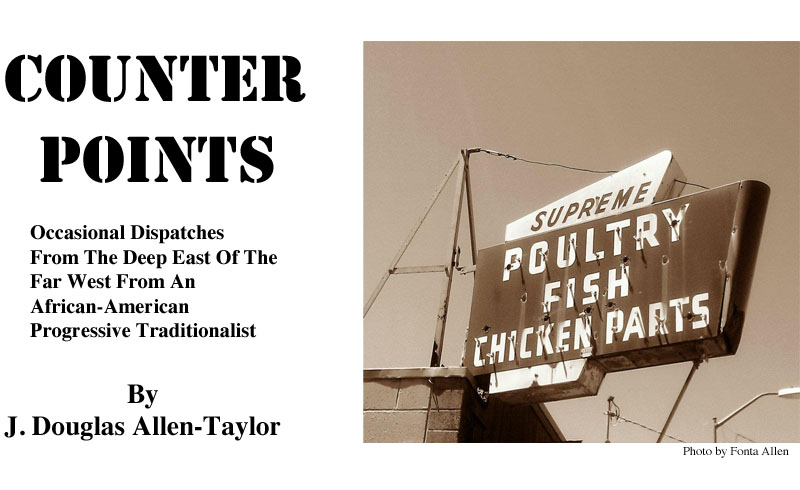|
|
WILL MURALS SAVE OAKLAND FROM GRAFFITI?
Are wall murals the overall solution to Oakland’s growing graffiti and property-tagging problem? The folks at Oakland’s street-art Community Rejuvenation Project (CRP) think so. Me, I’m not yet convinced. Anyone who lives in or travels around Oakland knows that the city is in the midst of a graffiti explosion. Once largely confined to railroad cars and freeway overpasses and abandoned buildings along the city’s western waterfront, the practice of unauthorized spray-painting of signatures or messages—some of them art, some mere scrawl—has expanded in the past two years or so to cover large stretches of public and private property in Oakland’s eastern and northwestern sections. In addition, while the taggers’ favorite target is still the inviting open spaces on the sides of buildings, those who wish to frustrate erasure and keep their offerings up as long as possible have begun switching to unfinished wooden fences and wire door and window gratings, where tagging is much more difficult to remove. Tagging is even spreading to traffic signs, where it can obscure important information and could potentially disorient drivers and impair safety, and more and more, graffiti is being written over billboards. One tag on a billboard near 90th and International now almost completely obscures a public message plea to stop Oakland’s violence. Whether one thinks it is an unacceptable blight on the city or the bright coming-out of a revolutionary urban art form, Oakland graffiti can only be ignored if one chooses to walk or ride around with their eyes closed. In the final day of the 2012 session, Oakland City Council moved to address the tagging issue, passing outgoing Councilmember Nancy Nadel’s and City Attorney Barbara Parker’s anti-graffiti ordinance on a unanimous vote (“Oakland Council Passes Graffiti Ordinance” East Bay Express December 19, 2012). Among other things, the new law enhances penalties for persons who tag properties in Oakland without permission and re-emphasizes fines for property owners who fail to remove graffiti on their property on a timely basis after being requested to do so by the city. Working through the several other local groups, the Community Rejuvenation Project lobbied hard against the new anti-graffiti ordinance, saying that it was hastily conceived and rushed through, unduly punitive against both the aerosol artists and property owners, that it would be unevenly enforced, and that it would not solve the city’s graffiti problem (CRP Statement on Oakland’s Proposed Anti-Graffiti Ordinance). Stating that “for many youth in inner-city areas, graffiti represents the voice of the voiceless and disempowered” and “is also often a reaction to the lack of art in public spaces and an expression of creativity” as well as “the first stage in artistic development” of those youth, the CRP proposed, instead, that Oakland City Council adopt what they call a “mural diversion program.” Under this proposal, groups like CRP would use many of the taggers themselves to paint city- and/or property owner-authorized murals in tag-heavy areas of Oakland, covering over existing tags and helping to eliminate the desire of taggers to create more. When I talked with CRP leader Desi W.O.M.E. (pronounced “womb”) about this mural diversion program several years ago I was very interested, in large part because I’d noticed that graffiti artists appeared to be avoiding tagging over murals in my own Deep East Oakland neighborhood. That avoidance has since changed in some instances, however, in the new wave of tagging. An Aztec-motif mural across from the Marcus Foster Post Office on 92nd and International, for example, now has messages tagged across it after years of being left alone. That trend was confirmed by a recent talk I had with the director of Los Angeles’ Office of Community Beautification, who told me that taggers in that city were now targeting murals because of the difficulty of removing tags from inside mural art (“Going After Graffiti” East Bay Express November 21, 2012). Although CRP asserts in their December 4 statement, above, that their plan is already successful, I have other concerns. Like all art, murals work best when interwoven with blank space. If we covered all of the tagged property walls in the city with murals, it would leave a jumble of confusion that would be as unsightly to the general public as the tags they are eliminating. In addition, the proposed mural diversion program would put the bulk of Oakland mural art decisions in the hands of the taggers, because only the murals they approved of would be safe from continuous defacement. I don’t think my concerns should be fatal to CRP’s mural diversion idea. I love murals. I appreciate the work CRP has been doing to create and preserve them in Oakland. And I am very much in favor of transitioning some of the aerosol artists into more advanced forms of their art. But like Oakland’s recently passed anti-graffiti ordinance—which I’ll discuss in more detail in another column—the CRP’s mural diversion program needs a bit more thought and work if it is going to be used to help solve Oakland’s growing graffiti problem.
|
